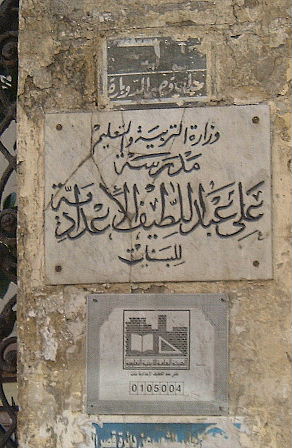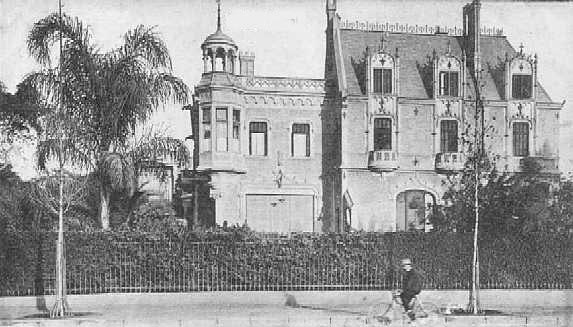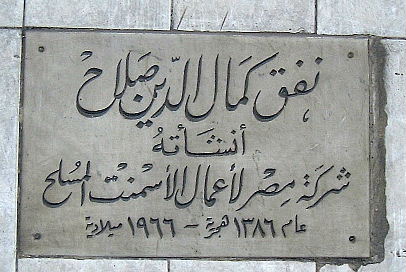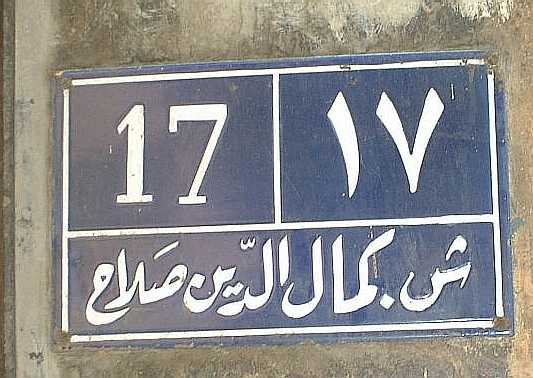Subject: Kamal El Dine Salah
Date: Mon, 28 Feb 2000 09:47:15 -0500
From: N.S in New York
Re: "Our Lady of Kasr al-Nil." I still remember the beautiful villa of Kout el Kouloub and the beautiful Tiffany-like stained window it had. Regrettably, our government did not keep any documents or information about anything. Sadly, we know very little about the Mohamed Ali Dynasty, albeit the (****) Nasser's dark era wanted us to know. No historian, no books, no nothing. We know the history of our great ancestors yet know nothing about our history 150 years ago.
Now, Kamal El Dine Salah was an unknown officer. He was in the secret service--Mokhabarat and was sent to Somalia in the early sixties to raise havoc as was the trend during the time of Nasser. His plot was discovered and he was killed. El Rais made a martyr out of him and gave his family royal treatment (including I believe 1 million pounds). His daughter is married to Ambassador Ahmad Aboul Gheit, the Head of the Egyptian Mission to the UN. Please do not believe anyone who tells you he was a hero. HE WAS NOT. Like you said, in Egypt whoever is killed in a railroad accident is ultimately a Shaheed; so you can imagine how a spy for Nasser at his time would have probably been considered a Saint.
Please keep up the good work. I love history and know a bit about it.
Subject: Out El Kouloub
From the Centre National de Documentation Pedagogique in France: A chapter (P. 229) on Kout al-Koloub by Julia Madoeuf can be found in "Entre Nil et Sable: ecrivains d'Egypte d'expression Francaise (1920-1960)" prefaced by Robert Sole; edited under the direction of Marc Kober, Irene Fenoglio and Daniel Lancon; 1999; ISBN 2-240-00610-2.
Subject: Kout al-Kouloub al-Demerdashia
Date: Tue, 29 Feb 2000 09:51:09 -0500
From: Mohamed El Shafie
Thanks again for all the information. Did you ever have the chance to stop by Ein-Shams Hospital, the one on Ramses St.? There you may still find an old marble plaque hidden under layers of cheap painting. It tells about the real story of this hospital and who actually built it. It was Moustafa El Demerdash. If you take a walk in the small alley next to it (full of Wanted people) you will find an old, almost destroyed palace overlooking Arab El Mohamady garden. That too belonged to Sit Kout. Most of the land around the palace, including the land on which the Coptic Patriarchate was built, was once part of Demerdash's extensive Cairo landholdings. I know you may already have this information, but I would appreciate it if you could give us some more.
Finally, my regards to this person who told you about Kamal el Din Salah. I'm not surprised to learn this about him. Is it not true that one of the longest roads in Cairo is named after S.S. (Salah Salem) the man who was supposed to protect the country but chose instead to protect his harem (one was an actress and the other a singer)?!
Regards
Subject: "Our Lady ", UNVEILED
Date: Thu, 2 Mar 2000 20:19:20 +0200
From: M. Osman
I believe blowing the whistle over the collective ignorance of contemporary Egyptians and exposing voidness of our education policies, should never stop. I know for fact that many foreign diplomats serving in Cairo deliberately put questions to their Egyptian friends, from all walks of life, revolving around "who is so and so" merely to ascertain their ignorance . Who is Ahmed Said (a flyover is named after him in El-Wayly district)? Who is El-Malek El-Saleh? Who is Finny (usually pronounced with a V) after whom a roundabout in Dokki is named. And the unified answer that keeps coming back is "he must be a famous man."
As for Kamal El-Din Salah, bestowing martyrdom on him was basically because he belonged to the brass. Had he been a civil servant he would have gone down a virtual incognito. The REAL credit of the role played in Somalia goes in fairness to Salah's boss at the time of the mission in Mogadishu, namely, the late Dr. Mohamed Hassan El-Zayyat (later, minister of FA). Another team member who equally merits recognition--not only in Somalia but in several others East African emerging countries of the sixties is the late Abdel Aziz Ishaq (a journalist-turned-diplomat, but his name was brutally obliterated as a result of conflict between professionalism and over posturing by his military superiors).
Your pessimism is well justified, and our acclaimed growth rate may be damned.
Subject: Kout El Koloub
Date: March 4
From: Omaima Foda
Kout El Koloub was by far the richest Egyptian woman of her time. Among her many fixed assets was prime real estate in downtown Cairo overlooking 26th of July Street (ex Rue Fouad). She also owned two apartment buildings on Saray El Ezbekieh Street where it meets Emad El Dine. In view of the response to your article I think the name of the Kasr El Nil bridge ramp should be renamed Kout El Koloub. I wonder if anyone still has menu cards from her dinner invitations. The translation from Arabic into French of certain local dishes was unique.
Subject: Article
Date: Sun, 05 Mar 2000 16:51:46 -0500
From: Mai Saleh
You are talking about ignorance and poor educational standards. Well, I know of kids who go to English schools in Cairo and actually don't know how to speak the language at all. Totally mind-boggling and a real shame. We're producing a severely mal-informed, mal-educated and a frighteningly narrow minded (to put it mildly) generation whose mere sense of knowledge revolves around "Hammam Fi Amsterdam" and the like!!
Mai
From Ann Lesch
Visiting Fulbright Professor
Cairo University

With reference to Samir Raafat's "Kasr Al Dubara quiz" of 2 March, Ali Abdel Latif was an Egyptian-born Sudanese of Dinka slave origin. he led the White Flag League, which supported Egyptian independence, and hoped that the Sudan (then under Anglo-Egyptian rule) would unite with Egypt. The British repressed the League in 1924, after encouraging protests in Khartoum and other northern Sudanese towns--which led to Abdel Laltif's "martyrdom." It is fascinating to discover that he is memorialized in Cairo.
From Caroline Tucker
Mounira
Samir Raafat decries the public's ignorance of local history, yet how does he expect it to know these facts if they're not taught in schools nor passed on orally from one generation to the next nor easily obtainable in general-interest books? No one contests that there's a general historical amnesia (and by no means just in Egypt), but instead of reveling in this to showcase his own knowledge, why doesn't Mr. Raafat concentrate on sharing that knowledge instead of whining about how we don't know anything.
Subject: Kout El Koloub
Date: Thu, 23 Mar 2000 22:06:18 EET
From: Amr Samih Talaat
Your article reminded me of a TV program I saw. The interviewer was quizzing university students on general knowledge. Here is the feedback:-
Q) Who is Makram Ebid Pasha?
A) An Islamic reformer!
Q) Which of Egypt's rulers awarded F. de Lesseps the Suez Canal contract?
A) Khedive Salah!
Q) How many times had Egypt and Israel fought since the outset of the conflict?
A) Twice!!!
At that point I got depressed and switched the TV off!
Kout El Kouloub was one of two daughters of "El Said" Abd El Rehim Moustafa El Demerdash Pasha, a wealthy landowner in the early years of the twentieth century. "El Said" was the title given to "El Ashraaf" or the "honorables," who are basically the Prophet's descendents.
It was Abd El Rehim Pasha who donated the land [and LE 135,000] for the building of El Demerdash Hospital which later became Ain Shams University Hospital. The 1929 bronze statue of Abd El Rehim Pasha [sculpted by Anton Haggar 1893-1962] is still in the center of the hospital's front garden in addition to two marble plaques bearing his name flanking the hospital's main gate.
The pasha believing his daughter Kout was brighter than her sister Hamida drew his will so as to pass all his fortune to the former with the exception of 500 feddans that went to the ill-fated Hamida.
Kout hanem lived a lavish life in her palace at Kasr El Doubara. In it she held an extremely extravagant wedding party for her only daughter Zeinab hanem and the famous journalist Aly Amin. The matchmaking was done by Kout's close friend, the great Um Kalthoum.
After 1952 Kout hanem fled to Europe. It is rumored that she herself married another famous journalist [Mahmoud Aboul Fath] at that stage of her life.
The family's house at "Arab El Mouhamadi" next to the hospital is still in their possession serving as the accommodation of Kout's son Dr. Ahmed El Demerdash. Kout had four sons and they all took on their mother's surname.
Dr. Ahmed El Demerdash is the current leader of their sect or Tariqa. His followers celebrate the birthday of "Sidi El Demerdash" every year in a grand ceremony with a religious tint, that takes place at his house.
Sharing the fate of all the other wealthy families present at the time, El Demerdash possessions were sequestered during the peak of Nasser's assault on Egypt's bourgeoisie. Some of these possessions were recently returned. These includes the building at the corner of Fouad and Ibrahim Pasha (Goumhouria) Streets. The court also ordered the evacuation of "Cicurel" department store that was situated at the ground floor of the building.
Last Kamal El Din Salah, although sometimes considered a member of the brass, was actually a graduate from law school and a diplomat. In 1953 he was posted counselor in Marseilles to act as a link between the Algerian rebels and Eygpt's budding military regime. In April 1954 he was transferred to Somalia to play a similar role. It backfired somehow and he was stabbed to death on 16 April 1957.
Amr Samih Talaat
From Nevine Shulkami
I was perusing my favorite website, egy.com [Samir Raafat's site], and came across Caroline Tucker's letter to the editor, "Don't Blame us, teach us" [printed in the Cairo Times 9 March, in response to Raafat's 2 March column: Kasr Al Dubara quiz]. While I fully agree with Ms. Tucker that "historical amnesia" reigns all over the world now, I beg to differ with the rest of her comments. We do not learn all our knowledge at school. We also learn by reading, by asking questions and by traveling. I think we need more people like Samir who try to enlighten us about how cultured, sophisticated and elegant Cairo was in the first half of the twentieth century. He is attempting, without whining or imposing, to make us feel how beautiful our country and capital used to be. Instead on commending Mr. Raafat for a job well done, Ms. Tucker attacks him. I find that sad, but being a foreign resident she may be unable to understand Egyptian feeling and pride. All educated Egyptians in North America are grateful to Mr. Raafat for what he is doing. We just need more like him. We do not need discouraging opinions.
Letter to Editor/Cairo Times
I, along with many of your readers I am sure, have been fascinated, informed and buoyed by the glimpses Samir Raafat has provided into the history of Cairo's landmarks. I miss his column when it skips an issue or two. Unfortunately I found myself agreeing with Caroline Tucker's letter [9 March] with respect to the column on Kasr Al Dubara [2 March]. The column's tone was not only pessimistic, it was condescending. And it was hopeless. I think Mr. Raafat could put his interest and skills to better use by inspiring his readers to learn more about Cairo's heritage and by offering constructive criticism on how to alter the current deficit in general knowledge on this topic.
I believe Mr. Raafat has so much to offer; it is a shame to waste his energy alienating the very people he is supposed to be encouraging to love our city. This is by no means a one-person job, however I for one, would be interested in learning how Mr. Raafat thinks those of us who are interested can play a role in preserving Cairo's rich heritage, or in simply gaining easier access to the sort of information that he has been doing such a wonderful-if partial-job of dispensing.
Laila Said
Subject: "OUR LADY OF KASR EL NIL" - Thanks for the memories.
Date: Tue, 28 Mar 2000 13:31:51 +1000
From: George Said
Organization: Melbourne PC User Group, Australia
Some time ago I wrote to you about your articles on Cairo and Heliopolis. I have many Greek friends from Egypt now living in Melbourne and they have a lot of interest in their country of birth. They are mostly in their sixties like I am. They are very interested to read your articles and some have asked me for copies.
Since we do not get Cairo Times and very few of my friends are on the Internet, I therefore would like to have your permission to print a few articles of yours in a newsletter. The newsletter is called "Sphinx" and is printed for a non profit organization called "League of Greeks from Egypt and the Middle East Incorporated". They have about 750 club members and the newsletter is printed every 2 months. If we gain your consent, your articles will appear without alterations as they are downloaded from your web site.
Thank you for the pleasure you have given me and my friends.
Your sincerely
George Said
Subject: From Montevideo
Date: Sun, 27 Aug 2000 20:56:37 -0600
From: Favy Moubayed
I love visiting your site and getting in touch with Egypt and everything Egyptian in it. Congratulations Samir, keep it up. Re: Your interesting page about forgotten and/or ignorance of modern history and origin of some names and sayings. Could you, or some of your readers, refresh my memory about:
1) history: "Shagaret El Dorr", and
2) the saying "Hokm Quaraquosh"
Thanks and kind regards
Subject: Kamal el Din Salah
Date: Mon, 05 Feb 2001 18:47:46 -0000
From: DAUGHTER OF KAMAL AL-DIN SALAH ( )
In response to Mr Samir Raafat's article "Analphabetism , Our lady of Kasral-Nil".I wish to clarify a few points for the mere wish of stating facts, since i am in a positionto know who is Kamal Eldin Salah,the late Egyptian Diplomat, who renderd an immense service to the cause of freedom and democracy in the early stages of the liberation of the African countries which sufferd under colonialism for long decade.
The late ambassador Salah,who some misinformed sources have claimed to be an Egyptian intelligence officer under President Nasser, sent to raise havoc in the then colonized Somaliland, was actually a career diplomat, nominated to the United Nations to act as a member of the Trusteeship Council advisory cmmitee jon the situation in Somaliland.He was one of three diplomats chosen by the UN to prepare for the independence of Somalilland. The two other doplomats came from the Philippines and Colombia.
He was born on May 28th 1910,and assassinated while on duty on April 16th 1957.He came from an Egyptian middle class family, the son of a judge,head of the Islamic Sharia(Jurisprudence) courts. He graduated from the Egyptian Faculty of Law(King Fouad University) and worked as a lawyer for sometime.
As a student he was always involved in national political activity,(Misr EL Fatah, with Ahmed Hussein and Fathy Radwan)who set up a project called (Mashrouh el Kirsh) meaning a project for collecting piasters for natiional action and called for the boycott of foreign goods and encouraging Arab products.
In 1936 he joined the Egyptian Foreign service and served in Palestine at the time of Amin Hussein, his boss at that time was Farag Taia, who later became foreign minister and who was also his boss during his service in Tokyo and Kobe,he then went on to serve in Lebanon, Greece (his boss was Ahmed Hakki) and in 1948 he was posted in Jordan as Charge d'affaires, then in Syria, Czechoslovakia, Sweden under (Samy Abul fetouh who later became foreign minister) and then consul General in Marseille.
His service in Somaliland was from 1954 to 1957, which ended with his tragic assassination at almost the close of hismission when he was about to file his report on the situation in Somaliland to the Trusteeship Council of the UN.
With all due respect to Mr Mohamed Hassan El Zayat,Kamal El Din Salah never worked with or under him, Mr El Zayat became his successor in Somalia.(that is to set the records straight for Mr Osman).
All this i believe is concrete evidence that the late Ambassador was actually an Egyptian Civil Servant, in the Foreign Service(in answer to M Osman 2nd March 2000,not from the Brass as he claims) he was an Egyptian,Arab and African patriot killed in the line of duty, fully worthy of being and Egyptian and a UN martyr.
His high esteem in Somalia by the successive leaders and all the Somali people is yet another evidence of his dedication and patriotism. Up to this present day important streets in the Somali Capital are named after him,as well as other public centers and institutions.He was given a huge heros funeral in Somaliland with full honours draped in the Somali Flag and his funeral in Cairo was a full fledge military one.
on his fifth anniversary, the Somali government extended an invitation to his family to visit Somalia to honour his memory, on the occasion a duplicate statue of the one placed in the entrance hall of the Egyptian Foreign Ministry, was unveiled in a club named after him in the Somali capital.
As for the so called Million Pounds compensation mentioned in the inacurate report by the uninformed (the least i can say) anonymous internet subscriber who only gave N.S for initials (dated 28th feb 2000), the truth of the matter is , that the total compensation receivedfrom the Egyptian authorities by his widow who is still living, Amina Mourad, his two sons Farid and Hesham and his daughter Laila, was the sum of five thousand egyptian pounds .The United Nations compensation was ten thousand dollars for his widow and five thousand for each of his children(it is noteworthy that at that time in 1957 the rate of the dollar was less than fifty piasters, while the lawyer who handled the transfer of the UN compensation recieved half of that amount for his services).
His memory is still being commemorated by the Somali people, and I personally felt very proud of my father when very recently by chance I met the president of Somalia at JFK airport boarding the plane to Egypt, My husband introduced himself as Ahmed Aboul Gheit Egyptian ambassador to the UN,(that is the only thing N.S was right about)he then pointed towards me and said that is my wife Laila Kamal El DIn Salah.
On mentioning my fathers name the president and members of his staff looked at me and said our Kamal El Din Salah, and they warmly paid tribute to my father, poointing out that Somalia owes its independence to Kamal El Din Salah's efforts and his name is mentioned in Somali history books as such,and that i should not cry that this great mans blood was not shed in vien,he is the Son of Somalia.
If as alleged, in the missinformed inacurate report by N.S. Kamal El Din Salah was a spy, in whos interest was he a spy when the Somali government has granted his widow honorary citizenship,and highly esteems and honours his memory??????
This is for those who are ignorent about a great Egyptian and Somali Martyr, wish there were more like him in this world.
With reference to the inaccurate information void of any truth about the Egyptian Martyr diplomat Kamal El Din Salah , i further wish to clarify yet another story which lacks all truth. With this i wish to refer to the statement by Mr Mohamed Shafie dated 28th of february 2000 (i don't have his address , or i would have forwarded this message to him) in which he sarcastically referred to one of the longest roads in Cairo named after the late Salah Salem a member of Egypt's revolutionary council.
The so called statement mentioned erroneously that he was a womanizer with connections to both an Egyptian actress and a singer.The fact is that his information is all mixed up ,he meant an Egyptian general who was a close confidant of the late Gamal Abd El Nasser, the main cause of Egypt's setback in the 1967 war as a result, that general committed suicide shortly after the 1967 defeat . this is only meant to keep internet users in the light about Egyptian history and set the records right.
Sincerely,
Laila Salah


